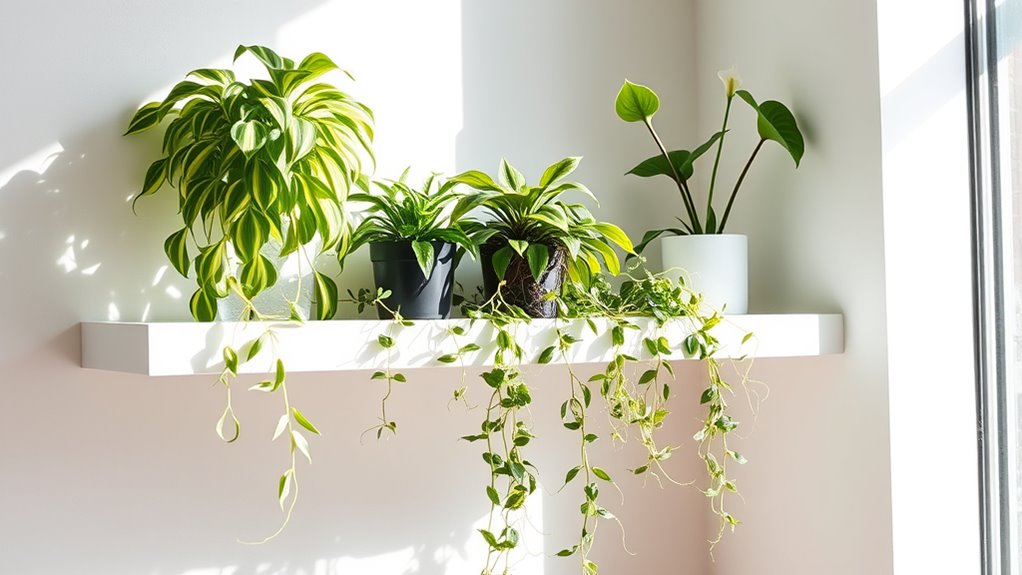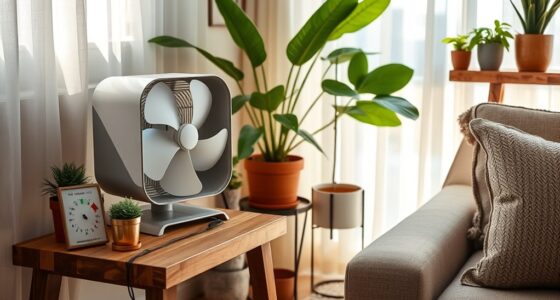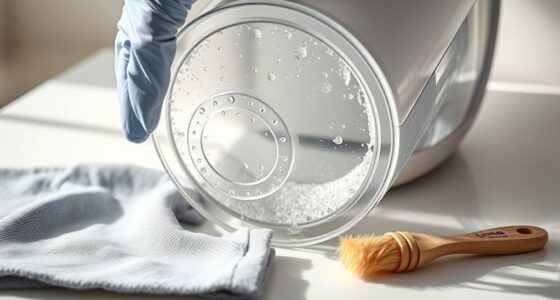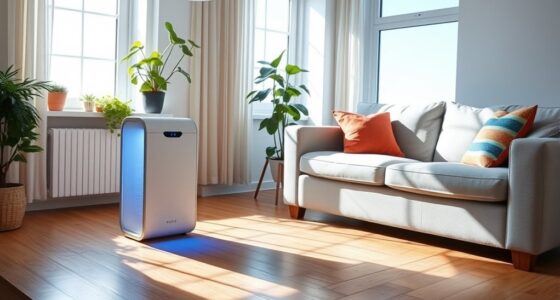To enjoy greener, cleaner indoor air while reducing allergy triggers, choose pet-safe, low-pollen houseplants like snake plants, pothos, or peace lilies kept out of reach. These plants produce minimal airborne allergens and help purify your home’s air by removing toxins. Proper placement and regular cleaning of leaves prevent dust and mold buildup. Keep exploring to discover which plants can help maintain a healthy, allergen-free environment tailored for your home.
Key Takeaways
- Choose pet-safe, non-toxic houseplants like snake plants and pothos to prevent poisoning and allergic reactions.
- Opt for plants with small or no flowers to minimize airborne pollen and allergen production.
- Incorporate air-purifying plants such as peace lilies to improve indoor air quality and reduce toxins.
- Regularly clean and wipe plant leaves to decrease dust and allergen buildup, supporting healthier indoor air.
- Proper placement and maintenance prevent mold, pests, and overgrowth, ensuring plants remain allergy-friendly and safe.

If you’re sensitive to common indoor allergens, choosing the right houseplants can make a big difference in creating a healthier home environment. Not all plants are equal when it comes to allergy potential, so selecting pet safe plants and low pollen options is essential. These plants can help purify the air without aggravating allergies or posing risks to your furry friends. Many popular houseplants produce minimal pollen or none at all, making them safer choices for allergy sufferers and pet owners alike.
Choosing pet-safe, low-pollen houseplants helps create a healthier, allergy-friendly home environment.
Pet safe plants are a top priority if you want to avoid accidental poisoning or allergic reactions in your pets. Plants such as spider plants, Boston ferns, and areca palms are non-toxic and generally well-tolerated indoors. These plants also tend to produce little to no airborne allergens, reducing the chance of allergy flare-ups. When choosing low pollen options, look for plants that have small, inconspicuous flowers or those that do not flower at all. For example, snake plants and pothos are excellent low pollen options because they rarely produce flowers, and their leaves are less likely to trigger allergic reactions.
Another key consideration is the plant’s ability to filter indoor air pollutants. Many allergy-friendly houseplants also serve as natural air purifiers, removing toxins like formaldehyde and benzene. Peace lilies, for instance, are known for their air-purifying qualities and are generally considered safe for homes with pets, provided they are kept out of reach of curious animals. These plants not only improve air quality but also tend to produce fewer airborne allergens, making them ideal for allergy-sensitive environments. Additionally, understanding how these plants can influence narcissistic relationships and emotional well-being can help create a more balanced home environment.
When integrating these plants into your home, ensure proper placement to minimize dust accumulation and to facilitate easy cleaning. Regularly wiping leaves and maintaining a clean environment will further reduce allergen buildup. Additionally, avoid overwatering, which can promote mold growth, another common indoor allergen. Opt for plants that require minimal maintenance, as they are less likely to develop mold or attract pests that could worsen allergy symptoms.
Frequently Asked Questions
Which Houseplants Are Safest for Pet Allergies?
When choosing houseplants for pet allergies, you want pet safe foliage and hypoallergenic varieties that won’t trigger reactions. Plants like spider plants, areca palms, and Boston ferns are great options because they’re generally considered safe for pets and less likely to cause allergies. Always double-check specific plant safety and keep your pets away from unfamiliar plants to prevent any accidental ingestion or reactions.
Can Allergy-Friendly Plants Also Help Humidify the Air?
While allergy-friendly plants primarily improve air quality, they also offer humidification benefits. You might think of them as simple air purifiers, but their plant moisture levels contribute to maintaining ideal humidity. This dual role helps reduce dryness, easing respiratory issues and skin irritation. By choosing the right plants, you get cleaner air and added moisture, creating a healthier, more comfortable environment that benefits both allergy sufferers and overall well-being.
Are There Specific Soil Types That Reduce Airborne Allergens?
You might wonder if certain soil types help reduce airborne allergens. Choosing soil with a fine, well-draining composition like sandy or loamy mixes can lower mold growth and dust mites, aiding allergen mitigation. Avoid overly moist or organic-rich soils that trap moisture and promote mold. By selecting the right soil composition, you actively minimize allergen presence, creating a healthier environment for allergy sufferers and supporting your allergy-friendly houseplants.
How Often Should Allergy-Friendly Plants Be Cleaned or Misted?
Think of your allergy-friendly plants as gentle air filters that need regular upkeep. You should plant dusting at least once a week to keep dust and pollen from settling like stubborn fog. Misting frequency depends on your home’s humidity, but generally, mist your plants 2-3 times a week to keep leaves hydrated and dust-free. Regular cleaning keeps your green companions fresh and your indoor air cleaner.
Do Allergy-Friendly Plants Require Special Lighting Conditions?
You might wonder if allergy-friendly plants need special lighting conditions. Generally, their lighting requirements depend on the specific plant, but most thrive in bright, indirect light. Proper plant placement is key; avoid direct sun to prevent leaf burn and ensure healthy growth. Keep in mind each plant’s needs, and adjust placement accordingly to provide ideal conditions without aggravating allergies. This way, you keep your space both lush and allergy-friendly.
Conclusion
Think of your home as a garden where allergy-friendly houseplants are your gentle guardians, quietly working to clean the air and soothe your senses. By choosing the right plants, you create a sanctuary that breathes with life and calm. Just like a lighthouse guides ships safely to harbor, these green allies steer you away from allergens, turning your space into a fresh, inviting oasis. Embrace these plants and let your home flourish with clean, healthy air.









